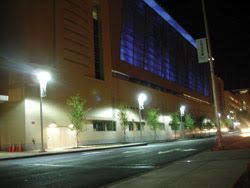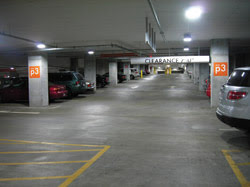In an effort to save energy, protect the environment, reduce energy costs and provide a better quality of light for improved visibility and safety, a coalition of government and industry called the LED City initiative has been formed to evaluate, deploy and promote LED lighting technology in cities across the US and abroad.
The first city to implement the project was Raleigh, N.C., which in December 2006 collaborated with Cree Inc., a local employer and major innovator in the field of lighting.

Downtown Raleigh, with two streetlight projects complete and a third under way, is now brightly lit and safer for pedestrians.
“Our commitment is to make available projects to test emerging LED lighting technology, implement them with the help of Cree and their vendor partners, and then tell the world about what we find out,” said Daniel A. Howe, assistant city manager of Raleigh.
In as little as six weeks, the first pilot project was complete. Since then, 11 projects in all have been implemented, including two streetlight projects, two parking deck projects with a third under way, decorative colored lighting, greenway underpass lighting, city parking lot and walkway lighting, and interior “can” fixtures, according to Howe. The city can also expect to see 95 percent of its traffic signals incorporate LEDs soon.
Future projects include studying solar LEDs, implementing high-bay lighting in pools and gyms, and including more types of interior lighting.
The overall response has been positive among city residents. After seeing the LED lighting in the convention center underground parking decks, even the city’s own construction management team found the traditional lighting in the stairwells so disappointing that it looked into retrofitting the stairways.

In Raleigh, N.C., the quality of lighting at the convention center’s underground parking facility has been dramatically improved under the LED City initiative. Images courtesy of the city of Raleigh, N.C.
“Citizens are very positive in their response to the quality of light,” Howe said. “Over 75 percent of respondents on a pre- and postimplementation survey of our first pilot project thought the LED level of our parking deck was both brighter and safer than the (high-pressure sodium) levels.”
Quality of light is not the only benefit residents of Raleigh will see. According to Howe, the city spends roughly 20 percent of its energy budget on lighting, including approximately $5.2 million each year on street lighting alone. With the LED initiative, the city anticipates that it will save between $300,000 and $700,000 over 15 years on the LED installation at the convention center and about $100,000 over 20 years on its streetlight project. Both figures take into account both maintenance and energy costs, with the savings depending on the price estimates.
“We have not calculated our mercury reduction impact by moving away from fluorescent and by offsetting the need for more coal-fired electricity generation, but that benefit is there,” Howe said. “Also LEDs typically save between 40 and 80 percent of our electricity costs.”
Raleigh’s commitment to becoming a “living laboratory” has proved successful, and other cities have jumped aboard the initiative, including Toronto; Ann Arbor, Mich.; Austin, Texas; Tianjin, China; Torraca, Italy; Anchorage, Alaska; and, most recently, Welland, Ontario, Canada.
“Quality is key,” Howe said, when asked what advice he would give to other cities considering the initiative. “Do your homework, and bone up on the new standards now emerging in the industry, especially the EnergyStar program for solid-state lighting recently published by the US DoE.”
With the adoption of LED lighting over the next 20 years, the US could reduce its electricity demands from lighting by 62 percent as well as eliminate 258 million metric tons of carbon emissions, according to the DoE. It could also avoid the construction of 133 new power plants and save more than $280 billion.
“LED technology has the potential to be the biggest shift in lighting since 1870, when we went from gas and oil lamps to incandescent lightbulbs,” Howe concluded. “I think we will see more dramatic changes and more standardization, especially in interior lighting, over the next two to five years.”